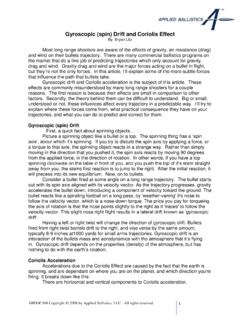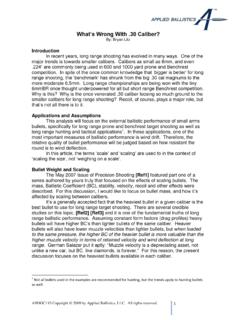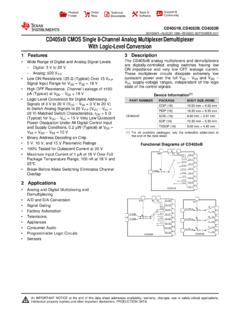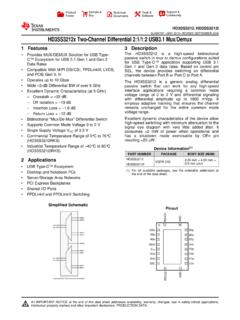Transcription of Maximum Effective Range of Small Arms - Applied …
1 Maximum Effective Range of Small arms By Bryan Litz In this article, I'll attempt to define a method for finding the Maximum Effective Range of a shooting system under the influence of predefined field variables. This is accomplished using a 6-degree-of-freedom (6 dof) computer simulation that is able to model real world factors influencing the rotation and translation of spin stabilized projectiles. I'll then show how the results can be used to make decisions about what type of rifle is right for a particular application, and how far a weapon may be successfully employed against specific targets. I'm basically attempting to improve on the antiquated logic that goes something like this: My rifle can hold a zero, and 1 MOA groups at 100 yards.
2 So if I have an accurate ballistics program indicating drop and drift, I should be able to hit a 10 target at 1000 yards . We all know this logic is flawed, but how, exactly? What are the non-linear effects that prevent accuracy at short Range to scale predictably at longer ranges ? Read on . Setting the Stage First of all, as engineers like to do, I'll start by making up words and assumptions in order to establish the scope of our study. The first term to introduce is the MER , or Maximum Effective Range of a weapon system. The MER will be established using a set of MER conditions. For this example, the MER conditions will be chosen to define the MER of a varmint-hunting rifle. The metrics we chose to define the MER of this kind of rifle are: accuracy and lethality (lethality being a combination of kinetic energy and terminal bullet performance).
3 If the bullet can be successfully delivered to the target with acceptable accuracy and lethality, the target is said to be within the MER of the shooter. The rifle that is modeled for this experiment is a .243 caliber rifle with a 1:12 twist, capable of MOA at 100 yards using 80-grain varmint bullets,1 at an average muzzle velocity of 3000 fps. The following MER conditions will be enforced. Accuracy: Shots must be guaranteed to impact within a 6 circle. Lethality: at least 500 ft-lbs of kinetic energy at impact. On our way to setting the stage, we introduce another term: field variables. In the present context, field variables refer to all of the things in the field that compound to cause a well-aimed shot to miss the target. Field variables include: misjudgments of wind speed and direction, Range uncertainties, variation in muzzle velocity, Coriolis acceleration, uphill/downhill firing, gyroscopic drift, air temperature, humidity and pressure variations, limited precision of sight adjustments, lateral throw-off, aerodynamic jump, etc.
4 For the present study, the field variables that will be used are: 1. The Sierra .243 80-grain Varminter bullet was used for this example. 1. Left to right (pure cross-) wind is assumed to average 5 mph, with a +-2. mph variation. Sights are adjusted to account for the 5 mph prevailing condition. 2. Muzzle velocity averages 3000 fps and has a +-10 fps error (20 fps extreme spread). 3. Firing may occur on any heading at 30 degrees 4. Air temperature, humidity, and pressure are known to a degree such that the air density can be calculated to within +-5%. The final results of the trajectory modeling will show how much each field variable contributes to the overall miss distance. Let's take a closer look at the field variables. There are several types of field variables.
5 One might choose to separate them by how relevant they are for a particular application. For target shooting at known distance with sighter shots allowed, most of the field variables are irrelevant. For example, when shooting targets, the heading of each shot is the same, likewise with the Range and air density. And so for target shooting these things are not variable and will have an identical influence on every shot. In fact for target shooting, the only interesting field variables are wind and muzzle velocity variation. However, a hunting or military application requires that all of the variables be considered due to the combinations that are likely to be encountered in the field. One cause of dispersion that is not really a field variable is the inherent rifle precision.
6 Inherent rifle precision is easily obtained by observing the grouping potential of the shooting system at short Range , before the field variables have a chance to influence dispersion. A 50 or 100-yard group fired from a bench rest or bi-pod in little or no wind is a reliable indicator of inherent rifle precision. Most varmint hunting rifles can be made capable of an inherent rifle precision in the Range of MOA. MOA will be used for the present example. Up to this point, we've defined our project and scoped its application. Keep in mind that most of the decisions made about MER conditions and field variables are simply assumptions. Different conditions could be chosen to define a different type of MER. There will be more discussion about selecting appropriate MER conditions and field variables later on.
7 Modeling Exterior Ballistics Using the 6 Degree-Of-Freedom Computer Simulation So far, MER conditions, field variables, and inherent rifle precision have been put under the microscope. Now lets take a closer look at our system. It doesn't matter what cartridge the .243 caliber rifle is chambered for, or how big the barrel is, or what kind of scope it has, etc. All that matters is that we know it's delivering the 80-grain bullets at an average muzzle velocity of 3000 fps at a twist rate of 1. turn in 12 inches and is capable of MOA groups at short Range . The bullets flight, on the other hand, is the most complex and important part of a Maximum Range analysis. Large amounts of time and effort have gone into 2. This is for calculating the Coriolis effect.
8 Searching for suitable tools to calculate the mass properties and aerodynamic coefficients of spin stabilized projectiles. Aerodynamics and Mass Properties This section may be considered optional reading for those not interested in the nitty-gritty of how the computer simulation works. The semi-empirical aerodynamic prediction module of the PRODAS code3. has been found to be most suitable for the task of generating aerodynamic coefficients for spin-stabilized projectiles. PRODAS calculates aerodynamic coefficients by applying special curve fits to an empirical database of wind tunnel and firing test results. An empirical method like this is much better at predicting aerodynamics in flight regimes that are governed mostly by viscous effects4, especially thru the transonic flight regime.
9 Also, since most bullets share relatively similar configurations, the slight variation of proportions means that the predicted aerodynamics for any bullet will not be too far from the observed aerodynamics of a bullet that was actually tested. It's really a well-suited tool for the application and represents the best aerodynamics prediction tool available (aside from actually performing a wind tunnel test or spark photography analysis of firing tests $$). The mass properties of the bullet are simpler to calculate than the aerodynamics, but no less important. Mass properties include the bullet mass, center of gravity, axial and transverse moments of inertia (Ixx and Iyy). These properties are very important to the static and dynamic stability of the bullet in flight.
10 Just like mass is proportional to an objects linear acceleration due to an Applied force (F=ma), the moment of inertia is proportional to an objects angular acceleration due to an Applied torque (T=I ). We're dealing with a gyroscopically stabilized projectile. It's very important to have an accurate description of the torque (overturning moment Applied by the aerodynamics) and the gyroscopic stability (resulting from the bullets spin) in order to model the dynamics of the projectile. Most discussion on the topic of stability is geared toward answering the question how much spin is needed to stabilize a particular bullet ? This is a very fundamental and important question to answer5. However there are other gyroscopic effects on a stable spinning projectile that are also important to quantify.












